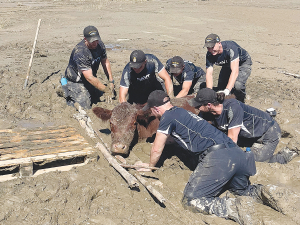Fonterra slashes forecast milk price, again
Fonterra has slashed another 50c off its milk price forecast as global milk flows shows no sign of easing.
 A cow almost entirely engulfed and trapped in silt was lucky to be spotted and rescued by a team of HMNZS Te Mana personnel travelling near the Tutaekuri River in Napier. Photo Credit: New Zealand Defence Force Facebook Page.
A cow almost entirely engulfed and trapped in silt was lucky to be spotted and rescued by a team of HMNZS Te Mana personnel travelling near the Tutaekuri River in Napier. Photo Credit: New Zealand Defence Force Facebook Page.
Around 100 farms remain inaccessible by road in northern Hawke’s Bay, two weeks after carnage caused by Cyclone Gabrielle.
Helicopters and fixed wing aircraft are being used by Fonterra, Beef + Lamb New Zealand and state farmer Pāmu to deliver food, fuel, communication equipment and vet supplies for farmers. No road access means Fonterra tankers are unable to pick up milk from 15 farms around Patoka.
Fonterra chairman Peter McBride told Rural News that these farms have dried off cows early and finished their season.
“My heart goes out to them,” says McBride.
Beef + Lamb New Zealand estimates between 70 to 100 farms have been impacted by landslips in northern Hawke’s Bay. BLNZ senior advisor William Halliday told Rural News that some farms between Patoka and Tutira were severely impacted. Halliday, who grew up in Patoka, says they were still in the intelligence gathering stage and it was too early to speculate on livestock losses.
“The big challenge for farmers right now is infrastructure – fences are down and in some cases sheep and cattle yards are gone,” he says. “It could be a while before some farmers would be in a position to do a head count.”
On feed supply, Halliday says there were very few requests for feed right now but it would be a crucial part of the recovery process.
During the first two days after Gabrielle struck, the communities were supplied with tinned food, nappies and sanitary products. Now choppers are flying in generators, fuel and even pet food.
Halliday points out that there are about 1,000 farm dogs in the region and they need to be fed.
State farmer Pāmu, formerly Landcorp, says its Hawke’s Bay and East Coast Pāmu farms have borne the brunt of Cyclone Gabrielle. Chief executive Mark Leslie told Rural News that the good news is that its people are safe.
“The most severe impact is to 22 of Pāmu livestock farms. Seven of our East Coast farms have had limited communications and access issues,” Leslie says.
Helicopters with emergency supplies were deployed from Taupō dropping in to do needs assessments with teams.
“General needs were generators, fuel, basic food, and GPS communicators,” he says.
“While out there we canvassed our teams for vulnerable neighbours and dropped in to see how they were. Thankfully, all are doing okay but have similar needs which we’ve since been able to meet.”
Fonterra has also flown in vets to help its farmers deal with animal health issues. McBride says Farm Source infrastructure has been mobilised to assist farmers.
“We’ve flown in vets to help farmers with animal management and also satellite navigation equipment to establish communications and find out what their needs are.”
Agriculture Minister Damien O’Connor, who visited affected farmers in Dargaville, Pukekohe and Hawke’s Bay told Rural News that this is the “most significant event the primary sector has faced in my living memory”.
“It has affected farmers from Kaitaia to Wairarapa but it has been very severe in Hawke’s Bay.”
He says the Government is doing all it can and the biggest challenge is damage to infrastructure.
Dairy prices have jumped in the overnight Global Dairy Trade (GDT) auction, breaking a five-month negative streak.
Alliance Group chief executive Willie Wiese is leaving the company after three years in the role.
A booklet produced in 2025 by the Rotoiti 15 trust, Department of Conservation and Scion – now part of the Bioeconomy Science Institute – aims to help people identify insect pests and diseases.
A Taranaki farmer and livestock agent who illegally swapped NAIT tags from cows infected with a bovine disease in an attempt to sell the cows has been fined $15,000.
Bill and Michelle Burgess had an eye-opening realisation when they produced the same with fewer cows.
It was love that first led Leah Prankerd to dairying. Decades later, it's her passion for the industry keeping her there, supporting, and inspiring farmers across the region.

OPINION: The release of the Natural Environment Bill and Planning Bill to replace the Resource Management Act is a red-letter day…
OPINION: Federated Farmers has launched a new campaign, swapping ‘The Twelve Days of Christmas’ for ‘The Twelve Pests of Christmas’ to…